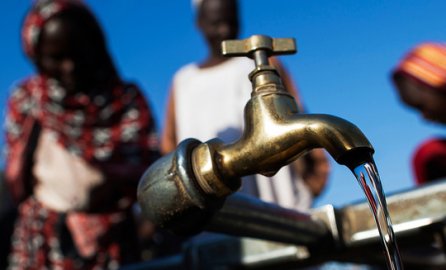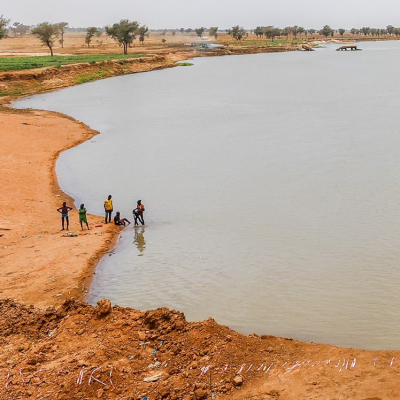Sustainable Development Goals call for ensuring the availability and sustainable management of water and sanitation for all by 2030. But water’s significance goes further.
Ghana’s economy shot up in 2011 at a rate of 14 percent as the country began to produce oil. But in 2015 the growth rate crashed to just 3.8 percent. Tens of thousands of jobs were lost, and the government was forced to seek support from the International Monetary Fund again. A big reason was low rainfall.
Ghana is mainly dependent on the Akosombo hydroelectric dam on the Volta River for electricity. As less water flowed from the Volta River to the dam, it operated at just half its capacity in 2015. Add in disruptions from geothermal plants, and in June 2015, electricity in the country was being rationed at 12 hours on, 24 hours off.
The crisis illustrates the widening importance of water management as global warming reduces resources and populations grow. Sustainable Development Goal (SDG) 6 calls for ensuring the availability and sustainable management of water and sanitation for all by 2030.
But water’s significance goes further.
Direct impact
The United Nations’ “World water development report 2016: water and jobs” demonstrates that water is related to several other SDGs, including Goal 8, which addresses the promotion of sustained, inclusive and sustainable economic growth, full and productive employment and decent work for all.
More than 1.3 billion jobs worldwide (42% of the world’s total active workforce) are heavily water-dependent, including work in agriculture, mining and industries ranging from paper to pharmaceuticals. Moreover, another 1.2 billion jobs are moderately water-dependent; though they do not use large quantities, industries such as construction, recreation and transportation do need access to some. In total, 78 percent of global jobs need water.
Investments in safe drinking water and sanitation have been shown to foster economic growth, with high rates of return. The recent Evaluation of the ACP-EU Water Facility gives some examples of direct jobs creation.

More than 1.3 billion jobs worldwide are heavily water-dependent, including work in agriculture © UN Photo/Harandane Dicko
In Zambia, the Water Kiosks installed under the "Support to improving Water Supply and Sanitation for the Urban Poor", have provided income opportunities for Kiosk Water vendors, solid waste collectors and caretakers of public toilets. It generated a saving and loans program that helped the Community.
Neglecting water can have potentially catastrophic impacts on economies and livelihoods, and could reverse hard-won gains in poverty reduction, job creation and development. That’s driving a need for imaginative solutions.
One way to conserve water resources is simply to use less. Brewer SABMiller, now part of Anheuser-Busch InBev, announced the aim to reduce water use to three litres per litre of beer produced and 1.8 litres per litre of soft drink. The company invested $1.75 billion in Africa between 2008 and 2013, including its direct operations, infrastructure and support for businesses along the value chain. In Sub-Saharan Africa, 56 indirect jobs are supported for every direct employee, resulting in a total of 765,000 jobs.
But even if water is used efficiently, dry countries will still struggle to meet their needs.
One solution is to reuse wastewater. “In countries that lack resources, using wastewater and promoting purification and reusing treated water is a source of economic development, as we know that a part of economic development is dependent on water,” said Céline Gilquin, Head of the Water & Sustainable Sanitation Division at the Agence Française de Développement (AFD). “If water is a constraint, let’s find additional resources to mobilise.”
Follow the flow
Wastewater comes in a variety of forms.
Emalahleni in north-eastern South Africa struggles with water scarcity, and has difficulty in meeting the water demands of its population of half a million. Demand for water is expected to increase in future, as the population expands rapidly.
The problem is being alleviated by a reclamation plant that converts water from a nearby mine into drinking water, water for industrial use and water safe for release into the environment. The treated drinking water now meets 12 percent of Emalahleni’s needs.

A reclamation plant in Emalahleni, South Africa, converts water from a nearby mine into drinking water, water for industrial use and water safe for release into the environment © Kate Holt/Africa Practice
Wastewater flows in the opposite direction too. Morocco has a huge phosphate mine, and the company that exploits it employs 20,000 people. It already uses 70 million cubic metres of water a day and it’s planning to double production, creating another 10,000 jobs.
Because the country already suffers from water shortages, the AFD is helping to purify domestic wastewater from three nearby towns, contributing half the $500 million needed. “Investments in water and purification are significant generators of employment,” said Gilquin of the AFD – “not necessarily directly in the sector of water and purification itself, but there are lots of sectors that depend on water resources.”
Weighing the costs
However, purification is often hampered by a lack of funds.
Many Arab states have long suffered from a lack of water, and demand has become more acute due to the arrival of refugees. To deal with this, at least 11 out of 22 Arab States have adopted legislation permitting the use of treated wastewater.
But in Lebanon, which is struggling to provide water for its population of over 4 million plus 1.5 million refugees, only 8 percent of wastewater is treated. Most collected wastewater is discharged into surface waters and the Mediterranean Sea. The country drew up a $3.1 billion plan in 2012 to collect, treat and reuse wastewater, but this has been disrupted by a lack of funding and political instability.
In the following video, Stefan Uhlenbrook, from the UN World Water Assessment Programme, and Céline Gilquin, of Agence Française de Développement, discuss water’s significance for economic development.
There are sometimes cheaper means to deal with wastewater than treatment facilities. In Washington, Indiana, combined sewer overflows were regularly contaminating local waterways, so the city constructed a system of artificial wetlands.
This discharged water exceeded the quality standards for the city’s wastewater treatment plant, and led to a return of wildlife to local waterways. The wetlands cost $26 million less than the estimated cost of building a conventional treatment system, and also save an annual $1.6 million in operational costs.
“There is always a discussion: Is it better to invest in grey infrastructure – big wastewater treatment plants – or is it best to look at green infrastructure?” said Stefan Uhlenbrook, Coordinator and Director at the UN World Water Assessment Programme.
“There are many costs and benefits that need to be assessed to make the right decision for an investment in a given situation. These kinds of stories really help in entering a dialogue with policymakers and advising on the best solution in light of the local circumstances.”
Image credit: UN Photo/Albert González Farran via Creative Commons license 2.0






(2)
Log in with your EU Login account to post or comment on the platform.
According to the World Bank, over 95% of Zambia's electricity generation is from Hydropower. The El Nino related 2014-15 drought led to the decline of about 50% of the country’s entire hydro electricity generation which in turn led to widespread load shedding of up to 8 hours per day - crippling economic development in agro processing, mining and commerce.
"Neglecting water can have potentially catastrophic impacts on economies and livelihoods, and could reverse hard-won gains in poverty reduction, job creation and development. That’s driving a need for imaginative solutions".
Although water is still a focal sector in 13 NIPs worldwide (if I am well informed), you wonder why in so many countries -where water was a key sector for the EU- it is not anymore a focal sector for the EU....
While 19 African countries have energy as focal sector in their NIP only a few have water left as focal sector. The examples of Ghana in the article and Zambia by Eric Buhl-Nielsen would propagate that you can hardly have energy as focal sector without having also water as focal sector (Nexus water-energy).